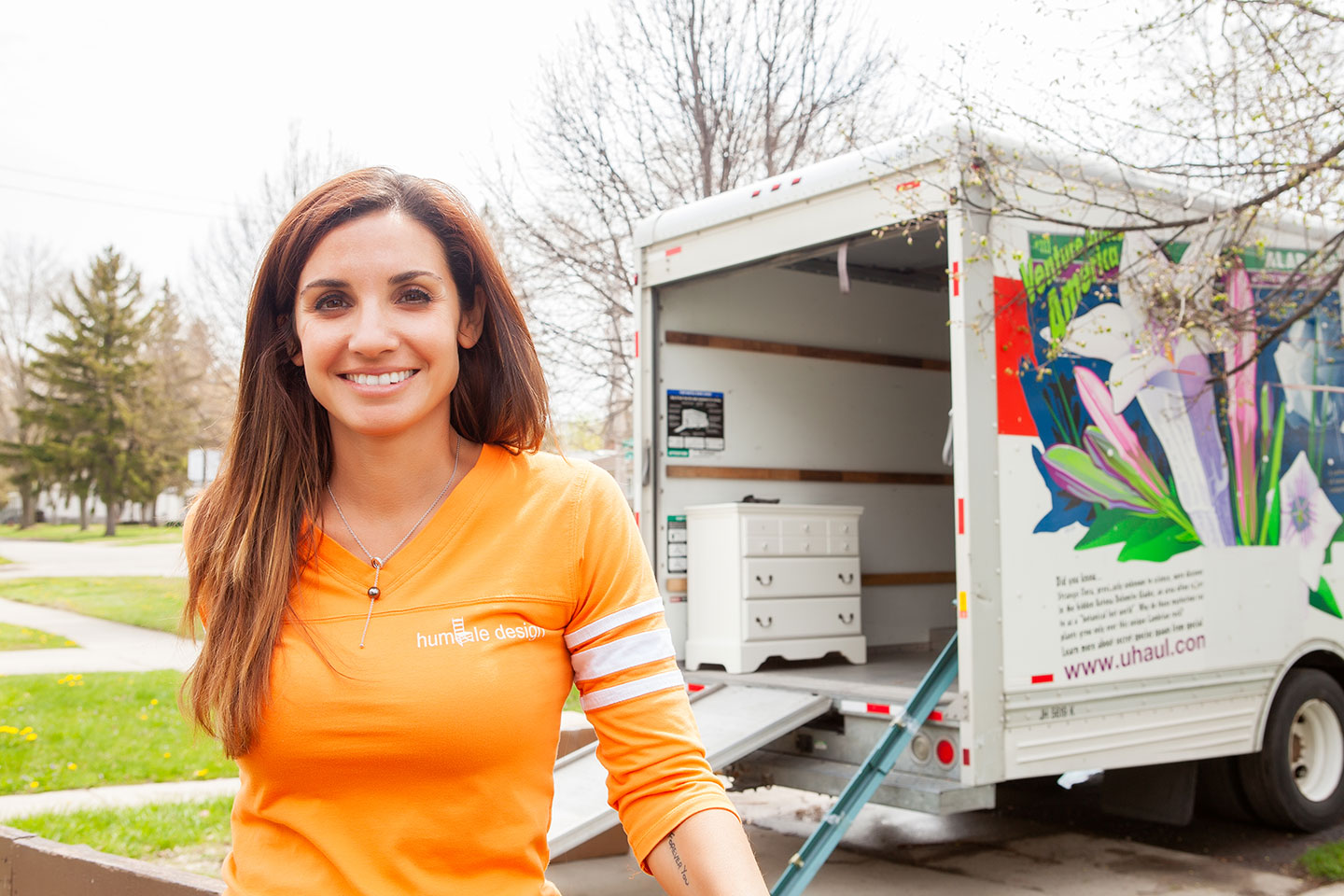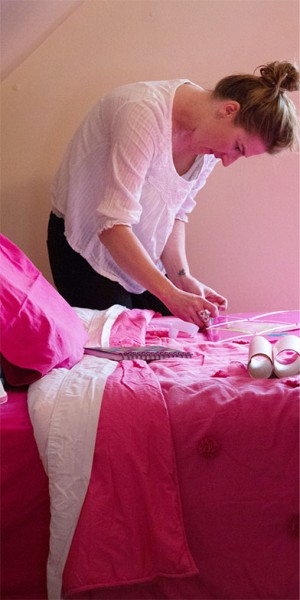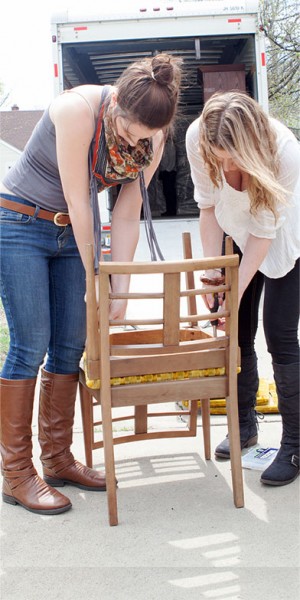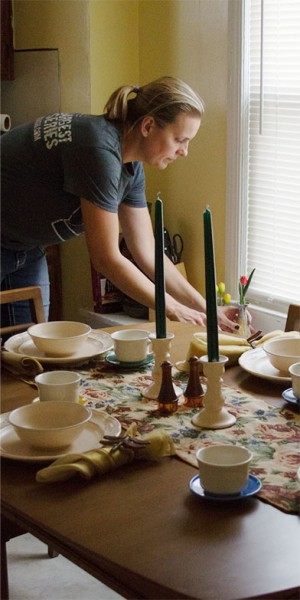It’s moving day. Spring has been stubborn to bloom, but the sun is breaking out of the clouds as we drive up to the bungalow with a wheelchair ramp on Lyndon Street in the Rosedale Park neighborhood of Detroit. We’re here to meet Treger Strasberg, co-founder and CEO of Humble Design, an eco-friendly, family-friendly, volunteer-driven nonprofit with extraordinary creative resources.
Spending a day with Treger on the job with her team at Humble Design will forever change the way you see that “spare stuff” in the closets, cupboards and storage space of your home. With the mission to assist families moving from homeless and abuse shelters to low-income housing, Humble Design works by turning bare walls and floors into clean, safe and welcoming homes furnished entirely by donated new items and gently used household goods.
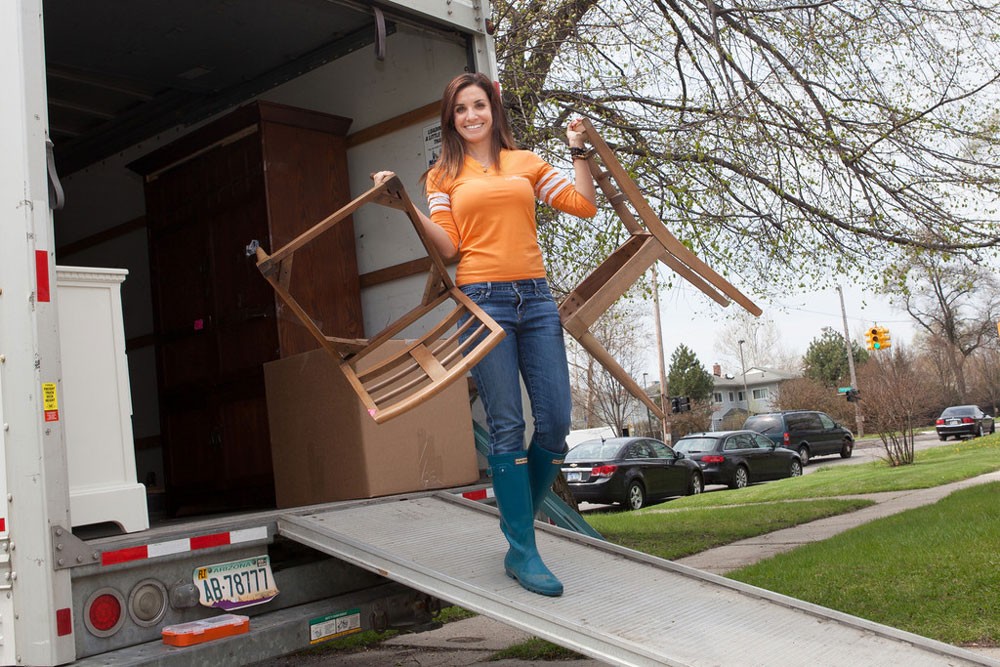
Treger is a self-proclaimed insomniac with big dreams and boundless energy. Unloading tools and cleaning supplies from her car, she explains, “Our services are a form of ‘uplifting regifting.’ Working on a shoestring budget, we could not do what we do without our volunteers. And our staff is absolutely amazing.”
Since its founding in 2009, Humble Design has helped establish households for nearly 400 families, working in partnership with South Oakland Shelter (SOS), Haven in Pontiac, Cass Community Social Services, Jewish Family Service, Habitat for Humanity, COTS and many others.
Awaiting delivery of her “Humble” new furniture, Treger’s client, Terri, greets us at the door. Confined to a wheelchair, Terri is assisted by her daughter Lonique and niece Brianna, both now living with her. From their cheerful demeanor, one would never imagine the hardships Terri and her girls have endured over the past year – losing their home, living out of their car, seeking a shelter equipped to accommodate Terri’s disability. Currently, Terri is on dialysis three times a week, waiting for a kidney transplant. She was in the hospital when her landlord evicted her from her home and threw her furniture onto the curb. With the help of Cass Community Social Services and a referral to Humble Design, Terri moved her family to the house on Lyndon in December.
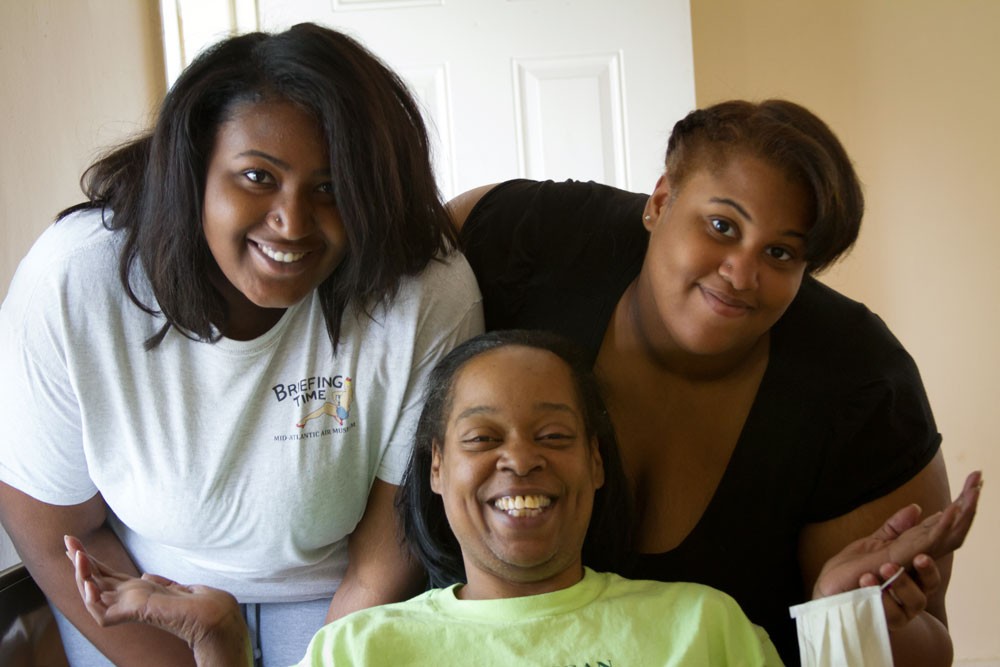
“How will it feel to have comfortable beds to sleep in tonight?” Treger asks the family. “Blessed, we are blessed,” Terri answers. As the truck arrives, the Humble Design team sweeps in. Like clockwork: movers, designers and volunteers deliver new mattresses, sofas, tables, dressers and chairs. Within a few hours, beds are made, rooms are furnished and decorated, cupboards are stocked, pictures and mirrors are hung, a table is set for a family meal. From top to bottom, the house is transformed into a home.
“Pinch me, is this really happening?” asks Terri, dabbing tears of joy. “No one has ever done anything this nice for me. Ever!”
Ever humble, Treger, takes no pay for her services and never will. Terri’s overwhelming gratitude is a typical response for Move-In Day with Humble Design and that’s all the incentive Treger will ever need to keep up the work at the helm.
On family background and education
Treger is an unusual name. Tell us about it.
I grew up as Sarah, the name my parents and husband still call me. Treger (pronounced Treeger) is actually my parents’ last name. In my family, my sister and I were the last in the line of Tregers. So when I got married, instead of losing that name, I made it my first name, took Sarah as my middle name, and took Strasberg, my husband’s last name, as my own.
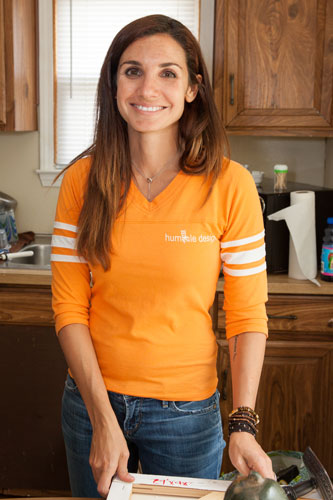
You started out as a ‘California girl’ – an artist educated in Israel and New York City. Tell us how you came to love Detroit and the work you do.
I was born in Columbus, Ohio, and raised in San Diego. My father is an ophthalmologist and my mom’s a college professor, now a lobbyist for charter schools. So, as you might imagine, I grew up in a household where it was really important to get a good education and to choose a field where you could succeed in life. When I told my parents I wanted to be an artist, they double-gulped but, ultimately, got behind the idea and sent me to art programs, including Wellesley for the summer.
My parents also instilled in me the value of giving back— always emphasizing the importance of having empathy – walking in other people’s shoes. I suppose that’s part of the reason big transitions and decisions have never been hard for me to make.
In the summer before my senior year of high school, I had the opportunity to go to Israel, and as it turned out, I stayed for my entire senior year. In Israel, I felt connected in a way I had never been before.
I graduated – went to New York City to study painting and drawing at the School of Visual Arts. One day, I met an artist on the street selling these amazing paintings for just $200 – and it dawned on me, even if I could replicate the quality of his work, I’d never make it as a painter.
So I switched my major to graphics. And that was the best move I ever made because the first class I signed up for was advertising, where I met my husband, Rob.
Rob moved down to Miami for a job; I stayed in New York and graduated, then followed him to Miami where we both worked in advertising for nine years.
On moving to Detroit
It’s funny the way things turn out. We were living in Miami and had two children, one and two, just 12 months apart. Rob was working crazy hours, traveling about 300 days a year, so we finally said, time for a change.
Rob had job offers in Los Angeles, New York and Detroit. And in my mind, with my family in San Diego, the choice was clearly L.A. But we came to Detroit for Rob’s interview at Doner – because I was ready for a hotel getaway and they were going to put us up at The Townsend.
So I left my babies for the first time with my mom – to live it up for a weekend in the D! I had never been to Detroit and in my mind, it was just burned-out buildings and tragedy. I drove around the city, just to understand. It was January 20th – the streets downtown were covered in snow, the lights were twinkling. In Birmingham, people were pushing babies in prams. I drove through Southfield and Ferndale and as I was driving around Royal Oak, heading back to the hotel, I had this epiphany — a moment of clarity: They need me here, I need my kids to grow up here and this is it for us. So when my husband came back from the interview, I said, “I hope they liked you, because we’re moving here.”
So he took a leap of faith with me, and we jumped off that cliff together. And it’s been the best decision that we made.
Why Detroit, why now?
There’s no place that I would rather be living than in Detroit right now.
What other city in America has so much room for growth and opportunity? If you want to be something, if you want to make something, if you want to create something—you have to be here.
As an individual you can shape this town— and I’ve met so many people here to help and open doors, with “What do you want to do? How do you want to grow?”
I have an outstanding Board and people in the community always are willing to meet with me. No one has turned me down. And when I ask corporations for their sponsorship, I have yet to have someone say no.
On starting up
So what can you do while the kids are at Temple Beth El day care for three hours a day? You find a volunteer job.
I started volunteering for Forgotten Harvest where I met a woman named Christa who ran the front office. Suit, nails, hair — she had the whole thing going, or so it seemed to me until she told me that she and her family were about to be homeless.
In all my years of charity work with my parents, I had never come face-to-face with homelessness. So I said no, that cannot happen, how are we going to fix this?
I knew my neighbors. I had Temple Beth El. And I had Ana Smith –a close friend, who would become my partner. We found Christa a house she could rent—but she was fleeing domestic abuse and had nothing but a couple of bags of clothing. So we called our friends, our neighbors, called people we didn’t know – asking for beds, linens, what do you have? It took us six weeks to gather all the furniture for the house and to decorate it . . . it was exciting work, but it was a project and, when it was done, I went back Forgotten Harvest.
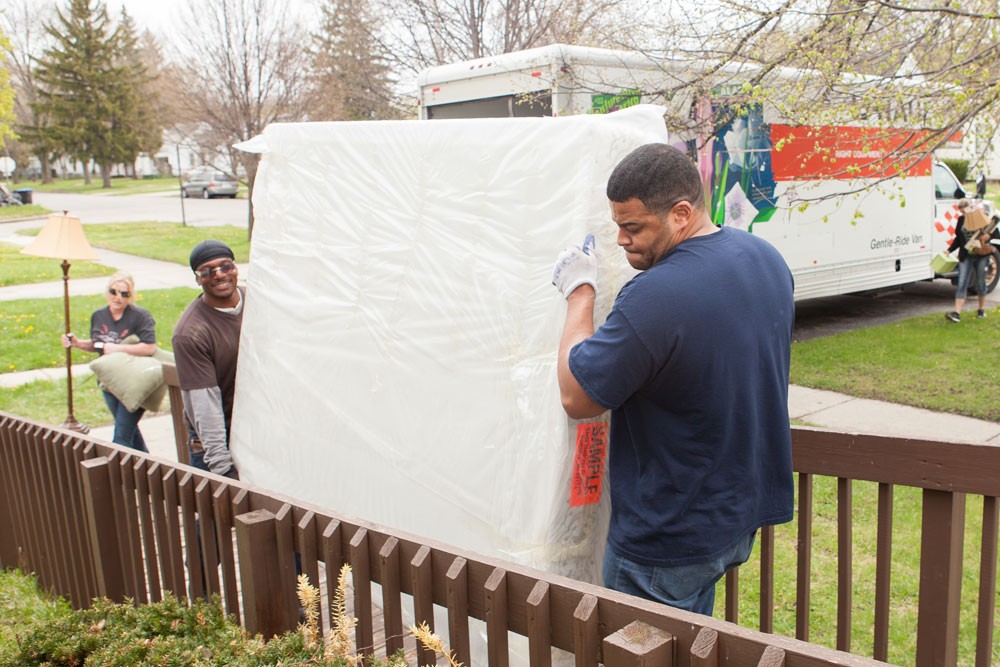
But still the furniture kept coming. I would come home and somebody would be delivering a crib to my garage, or leaving towels on my front porch. So we called the shelters, I called COTS, I called Haven — nine shelters — and we said we have all this stuff, and we don’t want it to go to a place where people have to purchase the items, we don’t want it to be resold to a thrift shop to fund programs. We want our donations to go directly to families who are in need in Detroit – and we don’t want them to have to pay for delivery.
We called all these places, and they all responded, “Hey that’s really a great idea, there’s nobody out there who does that!” And by the ninth phone call, Ana and I looked at each other and said, “I guess we’re in a nonprofit now.”
On growing
Humble Design was up and running for about a year. Our waiting list was growing. Tossing and turning in bed one night, I realized I couldn’t sleep because we had 100 people on our waiting list and that was 100 people sleeping on the floor that night while I tucked my kids into bed and lay in my own comfortable bed. I said to Ana, “We need to grow! We can’t do one house every six weeks. There’s so much more need that we’re not addressing.”
And to that Ana said, “I love you, I will sit on your Board forever, but I want to be with my kids and pursue other work, too. So Ana is our awesome vice president of the Board. But for me, this is it. Our moment in time.
We now serve three to five families a week.
How is that possible?
We have a system: On Monday our design team interviews families to assess their needs; the furniture is delivered on Tuesday and Wednesday, the design work generally comes on Thursday and Friday.
If we don’t keep to our schedule, it doesn’t work. We have two movers, a warehouse manager, a few designers on staff, but we count on our volunteers, generally two-to-four volunteers per house depending on the size. We have a pool 100 volunteers with about 60 really dedicated to the work. Those are the people who keep it running. I go out there, I get to smile for the camera and do interviews and raise the money.
How do you raise funds?
We have lots of events. And fun with them. Once a month we do a fundraiser. We also have small grants coming in, always applying for larger grants as we grow. Our operating budget has tripled in the last three years, we’ve moved from storage to a 12,000 square-foot warehouse in Pontiac, but our costs have stayed the same. Which is incredible.
$1,200 a house. That’s what we budget and that covers our cost in entirety – our rent, truck, gas, employees’ salary.
So when we have $1,200 in the bank, that’s when we donate a house full of furniture. Our Board has just approved the purchase of a truck, so there’s another major move forward for us.
On resources and partnerships
Today you’ve delivered beds, sofas, upholstered chairs, a dresser, even porch chairs. All new. Who are your partners?
Gorman’s donates their floor samples, all just amazing pieces, brand spanking new.
We get our beds wholesale at the cost of $150 for a mattress, box spring and frame. We don’t deliver furniture unless we have the beds first, because who wants to get furniture and art on the walls when they’re still sleeping on the floors?
We get a tremendous amount of support from Temple Beth El. Rabbi Syme has been a great champion of ours; a lot of our furniture and household goods come directly from our congregation.
Our Board is a powerhouse too, with people like Jim Hiller (Hiller’s Markets) and Loren Weiner – who helps out with refurbishing furniture. My husband Rob helps with every event, and the team at Doner is a constant resource of creative and marketing support. We’ve received grants from the Phillip and Elizabeth Filmer Memorial Charitable Trust, Verizon and Quicken Loans – and, of course, we’re always aiming for more.
Beyond moving day, are there other resources and services you provide?
We touch base with our families again in six weeks, then in six months . . . then in a year. First, we ask: is the furniture holding up, did we forget anything, is there a new baby, another person who moved in or out? We want to understand what’s going on with the family. If there’s someone who’s behind on utility bills, we’ll connect them with help. If someone has bed bugs, we’ll connect them with Orkin. If somebody wants to go back to school and needs a computer, we’ll connect them to our computer geeks in Birmingham. We try as best as we can to build this web of security so they can keep their home, rebuild their lives in it and ultimately give back.
On results
At the one-year mark, I would say that 90% of our families succeed in giving back. We don’t have to ask them.
Of the 400 families we’ve helped move, only 2% have returned to shelters. When you look at the standard numbers out there – the percentage hovers around 70%. Our families are beating the odds.
So we know what we’re doing is working.
On next steps
How do you see Humble Design growing?
Usually, a company starts out in an area that they feel they can tackle before they move to greater need. Humble Design started out in a community that has the greatest need in the nation. If we can be successful here, just think of what we can do for the other cities that don’t have as critical a need. Just imagine, how we can furnish every single home in need. In my mind, Humble Design needs to be nationwide. There’s enough furniture out there – you know it – there’s enough stuff people aren’t using in everyone’s home – to furnish every single person who’s leaving a shelter that exists in the U.S
We have this model. We know it works. We’d love to roll it out within the next five years. Fingers crossed.
Humble Design’s Wish List
Beds!!! Bathroom supplies. Shower curtains, bath mats, towels, linens. Anything that goes in your home goes in our homes. Bedding!! Did we mention bedding? Dressers. For more ideas, www.humbledesign.org.
Favorites
Restaurant: El Barzon
Place to meet for drinks: Sugar House in Corktown, next to Slows Bar-B-Q
Building in the skyline: The Terminal – holds so much potential – I just want to take it and redo it and put the windows in.
Place to take kids and visitors: Detroit Zoo
Vacation spot in Michigan: Harsen’s Island
Sport: Lacrosse! Big fans. My husband played for Penn State – so we love it!
Food: I love the Coney Islands here.
Likes to cook? Yes, I like to cook delivery
Never leave home without: Screwdriver. You never know what you’ll have to fix.
Reading
Lean In: Women, Work and the Will to Lead, by Sheryl Sandberg
Interesting Facts
My daughter’s name is Tuesday after the day my husband and I first met in class.
My son’s name is Henson – after Jim Henson of the Muppets.

